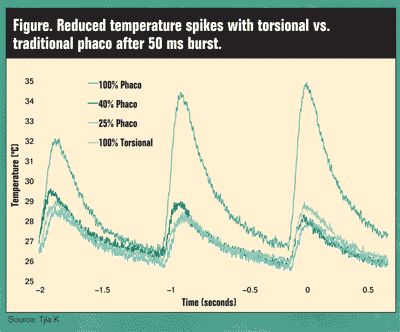Surgeon: Micro-coaxial torsional ultrasound uses smaller incisions
Torsional ultrasound also offers more effective transverse motion and lack of repulsion of nucleus matter, according to one surgeon.
Torsional ultrasound offers a more efficient means of cataract removal with a smaller incision and no risk of wound burn, according to Khiun Tjia, MD.
In addition to citing more effective transverse motion and lack of repulsion of nucleus matter from the tip as advantages of torsional ultrasound, Dr. Tjia said reduced heat production is another advantage.
Torsional ultrasound is ultrasound produced by a side-to-side movement of the phaco tip rather the axial movement of the tip as in traditional ultrasound, Dr. Tjia said. This type of movement is produced by the OZil torsional handpiece (Alcon).
In a presentation at the annual meeting of the American Society of Cataract and Refractive Surgery, Dr. Tjia said torsional ultrasound, operating with a frequency of 32 kHz, causes a 1º movement in the phaco tip shaft. Reduction in the friction between the tip and the sleeve, compared to traditional longitudinal phacoemulsification, also reduces the amount of heat produced (Figure) and subsequently reduces the risk for wound burn.

With 100% continuous torsional ultrasound with the Infiniti phacoemulsification system (Alcon), there is no risk for wound burn, said Dr. Tjia, an anterior segment specialist in the department of ophthalmology of the Isala Clinics in Zwolle, Netherlands.
Despite minute movement in the tip shaft, “the tip end has this brilliant swiping transverse motion without any repulsion,” said Dr. Tjia, who referenced tapered Kelman tips, which have eccentric tip end mass. Because the motion is transverse, as opposed to the forward-and-backward movement of longitudinal phaco, contact between the phaco tip and the nucleus remains constant, eliminating the repulsion of material common with longitudinal phaco, he said.
This maintained contact reduces the flow and turbulence in the chamber and allows better retention of viscoelastic, which protects the corneal endothelium, he said. In addition, longitudinal footswitch control with traditional ultrasound requires a balance between efficacy and repulsion. Without significant repulsion as with torsional ultrasound, footswitch control is no longer a problem, Dr. Tjia said.
Varying duty cycles
In addition, he said torsional ultrasound reduces the necessity of varying duty cycles common in longitudinal phaco and the amount of time the procedure takes. Less energy and more efficient motion reduces heat production at the wound site, reducing the need for a less powerful cycle to avoid wound burn. Pauses between pulses or bursts are not necessary in torsional ultrasound, he said.
Dr. Tjia also acknowledged the benefits of micro-coaxial torsional ultrasound (compared to bimanual phacoemulsification) as “identical to standard coaxial phaco, just smaller. There is a definite trend in cataract surgery toward smaller incisions,” Dr. Tjia said.
For more information:
- Khiun Tjia, MD, can be reached at Isala Klinieken, Locatie Weezenlanden, Groot Weezenlanden 20, 8011, JW Zwolle, Netherlands; +31-38-424-2980; fax +31-38-424-3334; e-mail: ktjia@isala.nl.
- Alcon, maker of the OZil torisional handpiece, can be reached at 6201 South Freeway, Fort Worth, TX 76134 U.S.A.; +1-817-293-0450; fax: +1-817-568-6142; Web site: www.alconlabs.com.
- Linda Christian is an OSN Correspondent who is employed by Vindico Medical Education.
